What do a licorice-flavored liqueur, a potent anti-viral and a natural fabric dye have in common? Care to venture a guess? No? Well the answer is they’re all derived from Elderberries. The very versatile Sambucus, a genus of large, flowering shrubs, has many other uses as well, not the least of which is its ornamental value.
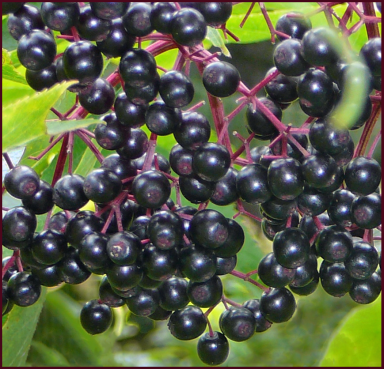
Sambucus nigra berries. Photo: Sue Gaviller
The berries are also used in jams, jellies and wine, the flowers are used in cosmetics, the hollow stems can be fashioned into musical instruments, and the dried leaves can be used as an insecticide. All parts of the plant, including the stems, bark, leaves and roots, are poisonous. The berries too, are reputed to have some toxicity to humans – if eaten raw. When cooked however, the toxins break down making the berries quite edible.
The real value to the horticulturist and the garden designer though, is ornamental. In our zone 3 climate, there are three species of Sambucus commonly used in the landscape: S. nigra (European black elder), S. canadensis (American elder), and S. racemosa (red elder). All have mid-green, compound leaves of medium to medium-coarse texture. Delicate white flower clusters appear in early summer, developing into very showy fruit later in the season – particularly the red-berried S. racemosa. In addition, the mature bark is quite interesting; reddish-brown with distinct vertical stripes.
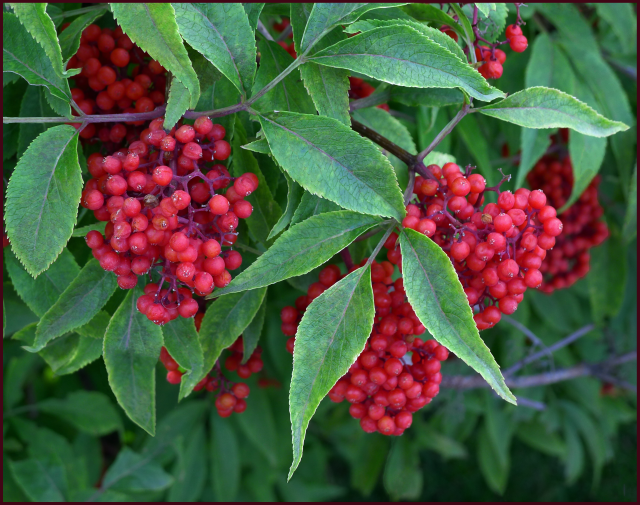
Sambucus racemosa berries. Photo: Sue Gaviller

Mature Sambucus bark. Photo: Sue Gaviller
Of greater note is the number of cultivars that have been developed from these three species – bred for colourful foliage, unique leaf texture, and flower colour.
More Colourful Foliage
In addition to the basic green of the species, gold, purple and variegated foliage colours are also available. One of the earlier gold-leaf introductions was Sambucus canadensis ‘Aurea’, a very intense yellow-green selection – hardy and robust. Numerous other golden cultivars are also available: S. racemosa ‘Sutherland Gold’, S. racemosa ‘Plumosa Aurea’ and S. racemosa ‘Goldenlocks’ to name a few.
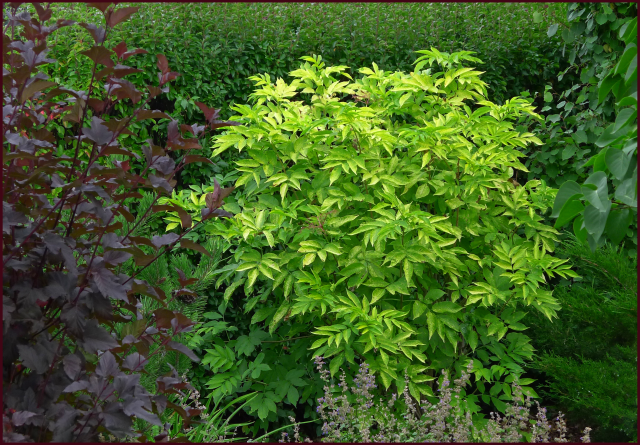
Sambucus canadensis ‘Aurea’. Photo: Sue Gaviller
There are also variegated cultivars, though I see fewer of them at local nurseries – in my own experience they are less reliably hardy, which may explain their inconsistent availability. Sambucus nigra ‘Madonna’ is usually available, and relatively hardy in our prairie climate – winter dieback can be a problem but re-growth is quite significant during the season. This cultivar has beautiful butter-yellow/green variegation on new leaves, turning to creamy white and green as they mature.
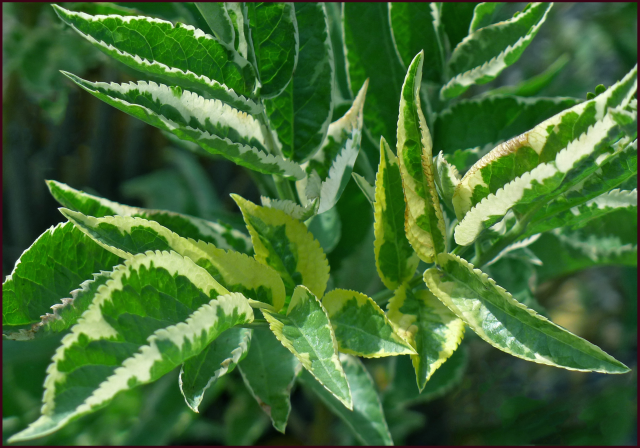
Sambucus nigra ‘Madonna’. Photo: Sue Gaviller
The original Purple variety, S. nigra ‘Purpurea’, had foliage that emerged purple but faded to bronze-green as the season progressed. This was followed by the almost identical ‘Guincho Purple’, which didn’t hold its colour very well either. The real breakthrough in purple foliage occurred with the introduction of ‘Black Beauty’, bred to maintain its dark, rich purple colour throughout the season. Indeed it does, and it’s also a very vigorous grower – especially widthwise, so give it some elbow room (unless you don’t mind pruning constantly). Most intense colour is achieved in full sun, with somewhat less saturated colour in shadier locations.

Sambucus nigra ‘Black Beauty’. Photo: Sue Gaviller
More Textural Interest
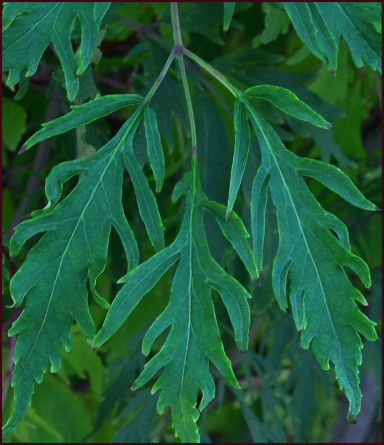
Sambucus nigra ‘Laciniata’. Photo: Sue Gaviller
Many Sambucus cultivars also exhibit fine lacy-looking texture. While all elders have compound leaves (which in itself provides textural interest), the cut-leaf selections have finely dissected individual leaflets, providing very unique textural appeal.
Sambucus nigra ‘Laciniata’, a green variety, was the earliest of these lace-leaf elders, but breeders went on to select for this characteristic in coloured cultivars as well.
![]()
The aforementioned gold cultivars, S. racemosa ‘Sutherand Gold’, S. racemosa ‘Plumosa Aurea’ and S. racemosa ‘Goldenlocks’ are fine examples of both bright colour and lacy texture. Another is the recent dark leaf introduction, S. nigra ‘Black Lace’.
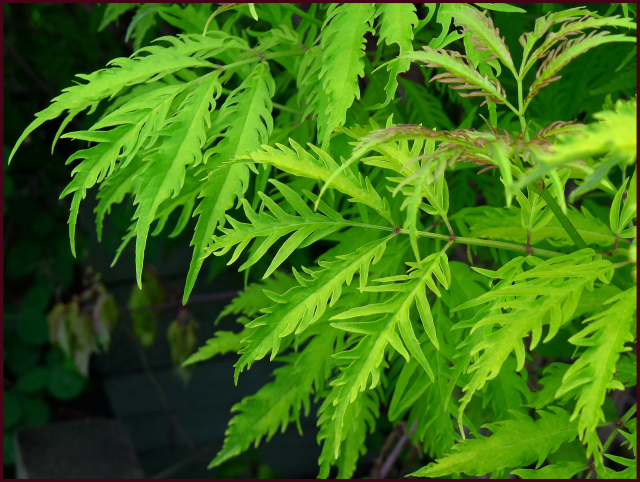
Sambucus racemosa ‘Sutherland Gold’. Photo: Sue Gaviller
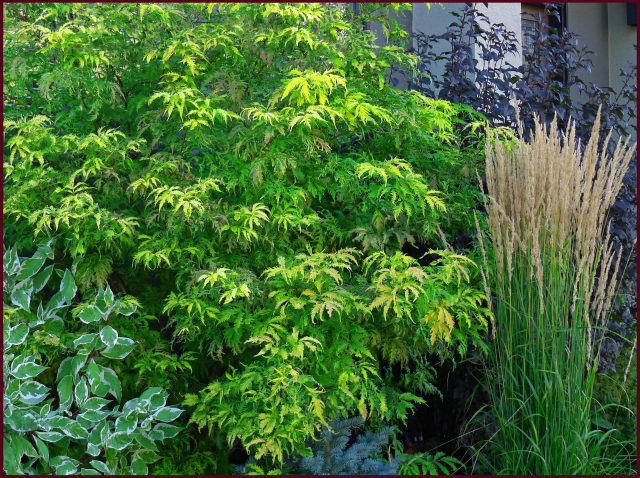
Sambucus racemosa ‘Plumosa Aurea’. Photo: Sue Gaviller
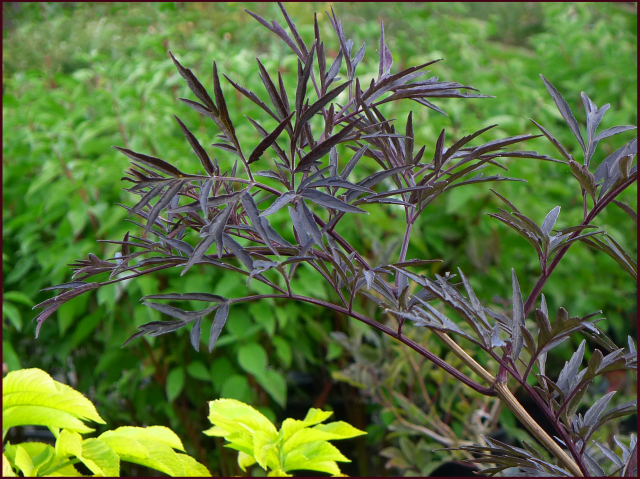
Sambucus nigra ‘Black Lace’. Photo: Sue Gaviller
More Flower Power
As if beautiful foliage colour and texture weren’t enough, a few of these lovelies also have stunning flower colour. While most elders produce the characteristic creamy white panicles, S. nigra ‘Black Lace’ and S. nigra ‘Black Beauty’ have exquisite pink flowers – a striking contrast to the dark foliage.
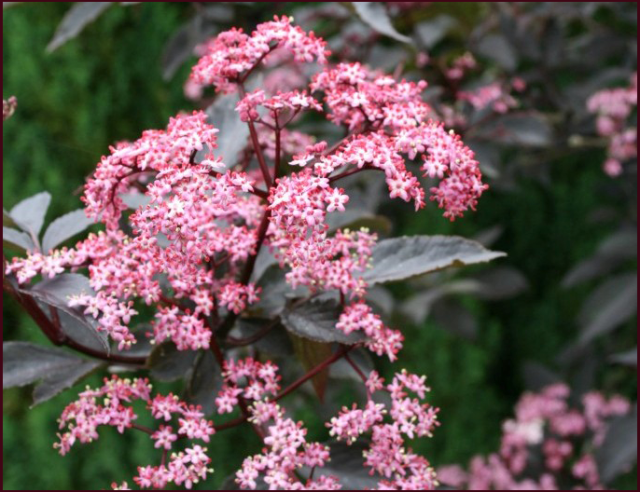
Sambucus nigra ‘Black Beauty’. Photo: Alison Pike, Alison’s Garden

Sambucus nigra ‘Black Lace’. Photo: Amanda Slater
More than Just a Pretty Face
The horticultural importance of Sambucus species goes beyond their design value. Their roots are deep and very dense so they’re useful for stabilizing slopes and controlling erosion – even along stream banks. To top it all off they provide food and cover for many birds – hummingbirds especially enjoy the nectar from the flowers.
So my gardening friends, show a little respect – your elders have much to offer.
Respectfully yours, Sue
Sue,
Sambucus canadensis ‘Aurea’ is my most favorite shrub. Each year, due to winter kill on the east side of the house, I cut them back to the ground and wait for them to faithfully out-perform. This year the one in front of the porch was 8’h x w 7’w and the one in front of the garage 7’h x 8’w. I also planted one in the back a year ago, it wintered without even a touch of winter kill; wish I could make that happen for the ones out front. Maybe I’ll try mounding them up with peat moss this year.
Sue, I love reading your blogs, you are a great story teller! As I read, I keep thinking, ‘children’s book’!
jeanne
Hi Jeanne,
Nice to hear from you and thanks for your lovely comment.
I know winterkill on our favourite shrubs is disheartening, but it’s good your Sambucus come back so vigorously every year – 8 feet of new growth in one year is performing indeed! Seems odd that it’s the ones on the East side of the house that are suffering winterkill though – you’d think they’d be more protected there, at least from the drying Chinook winds. Maybe try watering them in really well before hard frost since East exposure can also be in a bit of a precipitation shadow.
Hope the rest of your garden plans worked out this year – you had your work cut out for you (sorry).
As for the children’s book………..maybe one day.
Take care and thanks for being a faithful reader,
Sue
Hi Sue, Black Lace elders seem to die back to the ground every year, but do come back really vigorously the next year. The only problem I’ve found is with the blossoms — none to be had. Any suggestions as to why they don’t bloom?
Marion
Hi Marion,
Flowers form on previous season’s growth, so when the plant dies back to the ground, the flowers die with it. Locating the plant in a more sheltered spot may help to mitigate the winterkill, thus increasing the chances of blooming. Otherwise I guess one just has to accept that it’s a foliage plant only. I don’t use Black Lace elder very much – while I love its lacy texture, I find it has less saturated colour than Black Beauty. I’ve had problems with Black Beauty not blooming too – though previous year’s growth usually survives the winter, the current season’s growth is so vigorous that there’s a tendency to over-prune, thus removing the flowering wood. The key is not to prune too late in the season – flower buds form in August for the next year’s bloom, so pruning up until then shouldn’t compromise the following year’s bloom.
Anyways that’s the best I can offer – hope it helps.
Thanks for reading,
Sue
[…] Respect Your Elders […]
[…] Respect Your Elders […]
[…] Respect Your Elders […]
Hi, I have a Sunderland Gold which had been absolutely gorgeous for around three years. I have pruned in the autumn. However this year thought I would go with the instructions and prune after flowering in the spring. Not one of the buds came out. They are all brown and dead. What happened! Help! Corinne.
Hi Corinne,
When you say the buds didn’t come out, I assume you mean the leaf buds failed to open and the entire plant looks brown and dead? If so, it isn’t necessarily related to pruning schedule. It could be weather related – sometimes vast temperature fluctuations in the spring or fall can shut a plant down, often just temporarily, but sometimes can cause everything above the ground to die off. In the harsh climate I garden in, this is a relatively common occurrence, but maybe not so in your milder UK climate. There are several fungal infections that can also cause this – here’s a link with more info on diseases of Elderberry: http://homeguides.sfgate.com/diseases-elderberry-60045.html
The good news is it may regenerate from the base – if you wait a few more weeks, you might see fresh new shoots at the base. If not, then you’ll have to replace it – unfortunately if disease is the culprit, from a soil borne pathogen, the problem will likely recur, in which case planting a resistant variety is your best course of action. I have found Sambucus canadensis ‘Aurea’ to be the most robust of all the golden elders.
Hope this helps.
Thanks for reading,
Sue
Thanks for your reply. I picked off some of the buds and they just crumbled between my fingers. All brown and powdery. There are a couple that seem to be trying to put out some green. I suppose I shall just have to wait and see. I have grown it into a tree shape so it has quite a large trunk and of course huge roots. Not looking forward to trying to get it out! If I do and any infection is in the soil it could presumably kill anything I put in to replace it judging from the comments on the link you sent me. Let’s hope it s not infection. I am in the south east of England so have had a very mild winter.
Corinne
Hi Corinne,
Yes at this point ‘wait and see’ is your best option – I have made the mistake (several times) of pulling up an elder I thought was dead only to see lots of activity from the base of the plant. Had I waited another week, or even a few days, all this new growth would have emerged from the soil.
If it is a stem canker fungus that has caused the problem, there are pruning methods that will keep it under control (assuming the plant is indeed still alive) – I think the link I sent you should help you with this. If you don’t feel comfortable tackling it yourself, contact a certified arborist and they can do it for you. If your beloved elder has in fact expired and needs replacing, I’d try another elder and see what happens – not all disease causing pathogens are soil-borne; some are entirely within a plant’s vascular system, often a result of pruning with contaminated shears or other pruning equipment. It’s important to clean your pruners before you start cutting.
As well, there are plants that aren’t susceptible to these kind of fungal infections, so even if the soil is contaminated with fungal spores, there are alternative plants you could use – but cross that bridge when you come to it. For now we’re going to hope for the best – as one who gardens in a very harsh climate, I’ve learned to be patient in these situations (well I’m trying anyways). If I can do it, so can you!
Best of luck,
Sue
Hello Sue,
I’m considering using one of the Sambucus cultivars, because of it’s colourful, lacy foliage, similar to japanese maples, which are not hardy here in rural Ottawa zone 4b. I’d like to plant it in a foundation planting, with other shrubs/perennials. My concern is it’s size. I’ve seen it in one garden, where after winter kill almost to the ground, it shot up with 3 – 4 very long, 7 feet! stems (vase shape). In another garden, where the soil is drier and sandier, the same variety forms a very pretty, small – medium shrub, loose in appearance. It’s 3×3 feet at the most, much more tidy. I suspect that the sandy soil is the reason for the difference. In the garden I’m planning, I can’t have “wild” looking plants: everything has to be tidy and neat, with space between plants. To your knowledge, can any of the cultivars like “Black Lace”, “Black Beauty”, “Goldenlocks”, “Plumosa Aurea” etc fit this requirement? It’s ok if this requires additional pruning, as long as a natural shape of the shrub is maintained. I just can’t have the “unruly monster look”. Hope you could help.
Thank you for your wonderful blog, I’ve learned a lot.
Agnieszka
Hi Agnieszka,
Most of the elders you’ve mentioned will grow 6 – 10 feet tall & wide in your climate, even with winter kill. The exception is Goldenlocks which is a tidy dwarf – 3-4 ft height and spread. Of the larger cultivars, the only one I’d avoid is Black Beauty – while it is pretty, I’ve found its growth habit to be a bit unruly, especially in response to pruning. If what you’re looking for size-wise is smaller and more compact, I’d say the Goldenlocks is your best bet – the less pruning you have to do the more natural shape will be maintained.
Hope this helps – and thanks for reading!
Sue
Thanks a lot Sue, good to get your feedback. Agnieszka
You are most welcome – best of luck!
S.